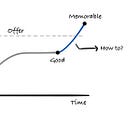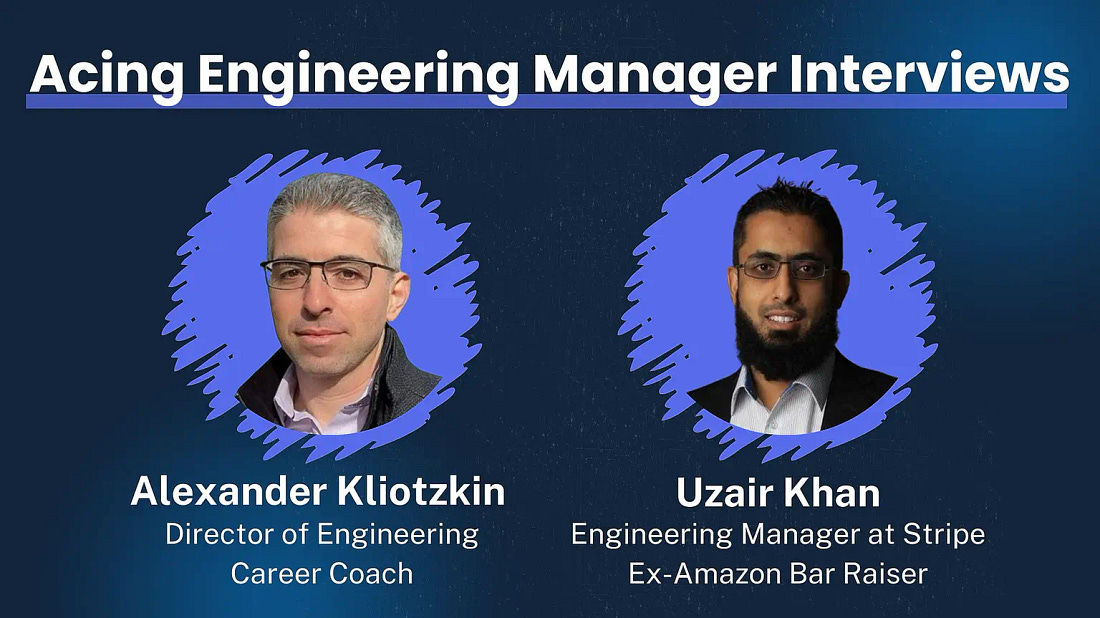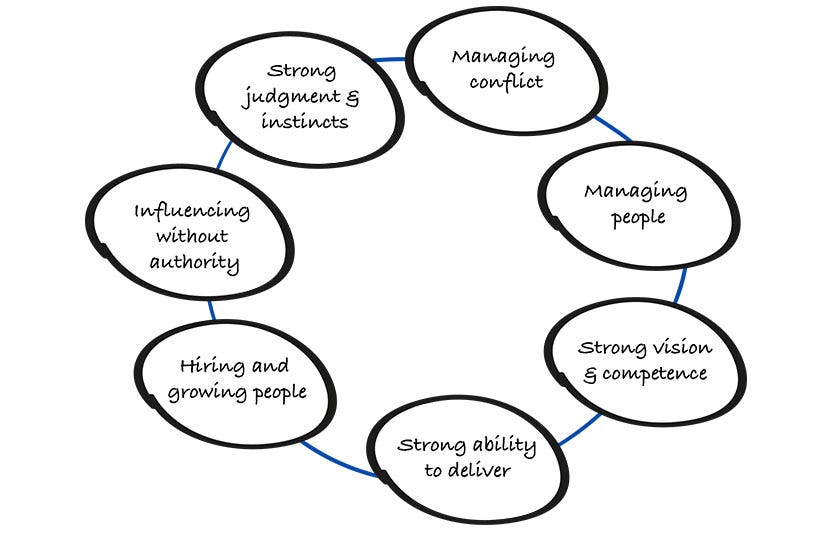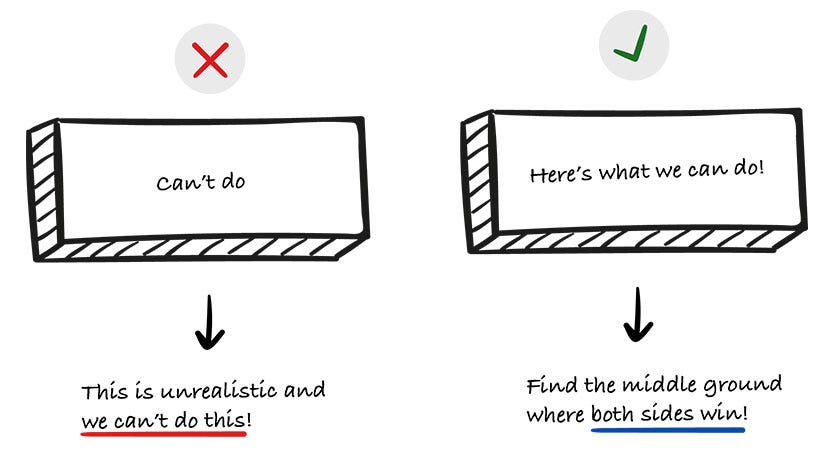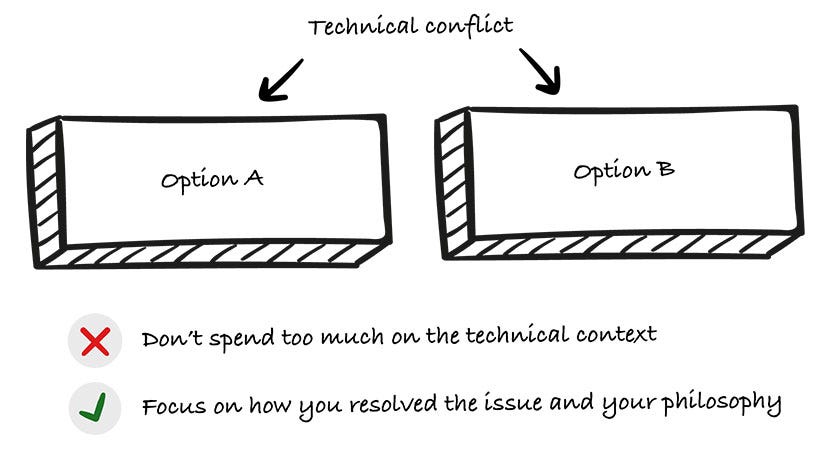7 Must-Have Engineering Manager Stories That Will Land You the Offer
- Gregor Ojstersek and Alex Kliotzkin from Engineering Leadership <gregorojstersek@substack.com>
- Hidden Recipient <hidden@emailshot.io>
Hey, Gregor here 👋 This is a free edition of the Engineering Leadership newsletter. Every week, I share 2 articles → Wednesday’s paid edition and Sunday’s free edition, with a goal to make you a great engineering leader! Consider upgrading your account for the full experience here. 7 Must-Have Engineering Manager Stories That Will Land You the Offer7 battle-tested stories from 50+ successful EM interviews!This week’s newsletter is sponsored by Cerbos. How to adopt externalized authorization: step-by-step roadmap. Hardcoded authorization logic doesn't scale. As systems grow and requirements change, those tightly coupled permissions end up slowing down development, creating security risks, and making compliance a nightmare. This 80-page eBook breaks down how hundreds of engineering teams have tackled this problem. It walks through the practical steps for moving from hardcoded permissions to externalized authorization. What's in it:
If you're dealing with similar authorization complexity, this might save you some of the trial and error. Thanks to Cerbos for sponsoring this newsletter, let’s get back to this week’s thought! IntroI held many engineering manager interviews in my career as an interviewer, and this is my top tip for being successful in a behavioral interview:
Good stories often mean the difference between landing the offer and not, and the reason is that they showcase your experience, the way you think, and your approach to solving problems. So, the main question that we want to answer today is: How to craft stories that will move the needle and get you the offer in your next engineering manager interview? Luckily, we have Alexander Kliotzkin with us today. He is sharing in detail 7 must-have stories that will make you successful in EM interviews! This is our second collab with Alex, and I highly recommend also reading the first article we did together to get a comprehensive overview of how to be successful in EM interviews: Introducing Alexander KliotzkinAlexander Kliotzkin is an experienced tech leader with 16+ years in the engineering industry. He is a Director Of Software at Infineon and also a Career & Leadership Coach. Together with Uzair Khan, Engineering Manager at Stripe, they are teaching a popular course called: Acing Engineering Manager Interviews, where they help EMs break through the interview process and land their Engineering Manager offer. Check the course and use my code ENGLEADER10 for 10% off. The next cohort starts September 6. The Harsh Reality About EM InterviewsAfter coaching over 50 engineering managers through interviews at Amazon, Meta, Palo Alto Networks, and countless other companies, I've witnessed a brutal truth:
EM interviews aren't about proving your technical prowess. They're psychological deep-dives into who you are when the pressure is on. They test your character, maturity, and emotional intelligence through behavioral stories. Each question has an underlying leadership competency that interviewers are hunting for. They're not just listening to your story → they're analyzing:
Here's what I've learned from watching hundreds of interviews:
Very important: Don't fabricate the "perfect" story where you made all the right moves and saved the day. Interviewers will ask follow-ups, and if you've embellished, you'll get caught. Raw authenticity beats fictional perfection every time. The 7 Leadership Competencies That Make or Break Your InterviewEvery behavioral question maps to one of these core competencies. Master these stories, and you'll walk into any EM interview with confidence:
Let's dive deep into each one. Story #1: Managing an Underperformer"Tell me about a time you managed an underperformer" This is hands-down the most common EM interview question. It evaluates your ability to build relationships, handle difficult situations, and make tough decisions when team performance is at stake. Where Most Candidates FailThey think they need to come out looking perfect. They either spend too long justifying their decisions or skim over the messy interpersonal details. But here's the truth: This question evaluates exactly how you deal with conflict. Interviewers want to see the difficult conversations, conflicting viewpoints, and real human dynamics. Other red flags that kill your chances:
FrameworkStart with your philosophy, then show it in action:
StoryContext & philosophy: "One of my senior engineers started missing sprint commitments over two consecutive sprints. His velocity dropped 40%, and team morale was suffering. My philosophy is simple: one underperformer affects the entire team's performance and sets dangerous precedents. But, I do my best not to jump to conclusions → I always seek to understand first." Difficult conversation: "During our 1:1, I discovered he was struggling with our Spring Boot stack. He was a senior engineer I'd inherited, who had experience with Spring Boot, but never on major features. He felt insecure and was spending excessive time on basic concepts, which created a shame spiral." Plan: "We created a development plan: paired him with a mentor, established weekly check-ins with specific output metrics, and set a 30-day improvement timeline. I also made it clear that future struggles needed immediate communication, not silent suffering." Outcome & learning: "After a month, he was performing to expectations and became one of our strongest contributors. My key learning: I should have had clearer conversations about role evolution upfront. The upskilling conversation should have been proactive, not reactive." Story #2: Keeping Your Team Motivated"How do you keep your team motivated/engaged?" / "What's your leadership style?" This question essentially evaluates your leadership style. Your ability to influence your team in a sustainable manner. Motivation is not a one-time act but a continuous process that goes beyond pep talks, free lunches, and short-term incentives. You need to show you understand what it takes to influence your team, and not just go by gut-feel. Where Most Candidates FailThey're all over the place without a structured answer, leaving the impression they don't have a real system. They rely on generic responses about team lunches and bonuses instead of demonstrating a thoughtful leadership philosophy rooted in concrete actions. FrameworkPresent your system, then show it in action:
StoryMy motivation framework → "MAP"
Situation: "Last year I inherited the Checkout & Payments team, 14 engineers who had just finished a stressful PCI audit. Two weeks later the CEO announced a fast-pivot: launch in three new countries within six months. Morale was shaky and burnout risk was real. My job was to re-ignite motivation, keep the team whole, and still deliver the multi-country launch on time." Action (using MAP): Meaning:
Autonomy:
Progress:
Result: "Morale score rose by 10% in three months (pulse survey). Zero attrition, two senior engineers who were interviewing externally withdrew their applications. We hit the six-month launch; new-market GMV up 12% Q/Q, and our eNPS question “I understand and believe in the team vision” jumped 26 points." Important to mention: MAP Framework gives me a repeatable playbook, start with purpose, pair autonomy with guardrails, and make progress visible to sustain motivation even under aggressive timelines." Story #3: Ensuring Sustainable Delivery"How do you ensure your team delivers sustainably?" / "What processes do you establish?" Senior leaders don’t rely on intuition alone → they build repeatable systems. This question evaluates whether you have a structured approach to sustainable delivery, and if you can bring that playbook to your next role. Where Most Candidates FailThey don’t show a structured system. Their answers feel reactive instead of intentional → jumping from stakeholders to JIRA to leadership meetings without connecting the dots. The result is a vague, high-level response that doesn’t translate into concrete actions or repeatable processes. Don't just say "we do standups, where we track JIRA tickets." Show a sophisticated system. Example → my 3-layer delivery framework: Layer 1: Strategic alignment (outside-in)
Layer 2: Execution excellence (inside-out)
Layer 3: Team health (human-centered)
StorySituation: "At my previous role, we were drowning in ad-hoc support requests that were derailing our sprint commitments. The team was frustrated, stakeholders were unhappy, and we had no visibility into why we kept missing deadlines." My systematic response:
Impact: "Support tickets decreased 40% over two quarters. Sprint predictability improved from 60% to 85%. Most importantly, the team felt in control of their work again instead of constantly reactive." Story #4: Scaling Your Team"Tell me about a time when you scaled your team" Hiring is crucial to team culture and is the most important decision you'll make as an EM. This evaluates your ability to grow both people and processes while maintaining quality and culture. Where Most Candidates FailThey focus too much on the company hiring process, appearing passive. They don't emphasize their own philosophy, opinions, and leadership values in the scaling process. Strategic Approach to ScalingStart with business need, not headcount:
Bonus: For more senior roles, show how you are proactive in your hiring approach. You have a network of suitable candidates, you keep in touch with talented people you worked with before, and you have an intern program to find talented juniors. In short, you have a talent pipeline that you can call on anytime. StoryBusiness context: "I was asked to lead the UI and observability charter for the Data Foundation team. I needed to build a team from scratch while facing an immediate deadline → a Big Tech Summit was just months away, and we had to deliver a demo-ready MVP." My strategic approach: Immediate foundation: "I negotiated with leadership to bring two high-performing engineers from my existing team to lay the foundation quickly. This gave us momentum while I built out the rest of the team." Business-driven hiring strategy: "After working closely with architects and PMs to understand the technical roadmap and customer needs, I created a headcount forecast. Given our tight deadlines, I decided on a senior-heavy team who could operate independently and deliver effectively under time constraints." My hiring philosophy: "I prioritize mindset over specific technical skills. I look for people who can operate with autonomy, collaborate effectively, and grow with the product rather than requiring extensive hand-holding. I want engineers who can evolve with our needs." The process I established:
Onboarding for success:
Results: "Over 6-8 months, I grew the team from zero to eight engineers. We successfully delivered our initial version on time for the Big Tech Summit. The team eventually grew to 15 members (including a merger that added five more engineers) with a 95% retention rate. We delivered 18 releases on schedule and contributed to $100 million in revenue." Story #5: Managing Stakeholder Conflicts"Tell me about a difficult situation with a stakeholder" As an EM, you're the bridge between your team and the outside world. This evaluates your ability to influence without authority and build consensus under pressure. Where Most Candidates FailThey approach it the wrong way. Instead of showing how they built the relationship, they go on the defensive and spend their time justifying their position. They talk about abstract groups → “the PM team” or “the org”, instead of focusing on the one individual they actually had to influence. And they skip over the messy details that interviewers really want to hear: the tension, the pushback, the conflict, and how they navigated through it. This is fundamentally a relationship question. Interviewers want to see how you handle tension, build trust, and find win-win solutions when conflicts arise. StoryConflict: "Our primary PM wanted to commit to shipping three major features in a single quarter to hit an aggressive revenue target. Based on our team's velocity and the technical complexity, I knew this timeline was unrealistic and would likely result in technical debt that would slow us down for months." Tension: "The PM's perspective was valid → the sales team had made commitments to enterprise customers, and missing the timeline could cost us significant deals. My concern was equally valid, rushing would create instability that could hurt existing customers." My approach:
Resolution: "We agreed to ship two features with full quality standards and launch the third as a limited beta with select customers. This allowed the sales team to demonstrate progress while maintaining our engineering standards." Learning: "The key was reframing the conversation from “can't do” to “here's what we can do.“ When you come with solutions, not just problems, stakeholders become partners, not adversaries." Story #6: Decision Making Under Uncertainty"Tell me about a time you made a difficult decision without complete data" EMs are paid to make difficult decisions on architecture, priorities, and strategy. This evaluates your decision-making process and risk tolerance. Where Most Candidates FailThey don't communicate their approach clearly and spend too much time on the situation itself → why it was difficult, the boundary conditions, potential pathways. That's not what the question is asking. It's asking about your criteria to make the decision. You also need to choose a story that truly shows you didn't have enough data. Often candidates talk about a difficult decision, but not because of lack of data. Ensure your story addresses a situation where you truly didn't have enough information and needed to make a judgment call. That's the key: your judgment. FrameworkShow your mental model:
StoryThe Crisis: "At my last org, we had a critical opportunity to materially increase customer cash inflows by launching Direct Deposit Switching in Q3. We faced a classic build-vs-buy dilemma: build payroll connectivity in-house (slow but controllable) or integrate with a third-party vendor like Pinwheel (fast but risky). Marketing had secured budget and a narrow launch window, but we lacked complete data on vendor coverage, employer-specific reliability, and real-world failure modes that could impact our compliance posture." The data constraints:
My decision-making process:
The outcome: "We chose the vendor partnership with explicit guardrails: feature-flagged staged rollouts, manual fallbacks, live-ops playbooks, and a kill switch for error rates above 15%. We launched MVP in 7 weeks versus the 4-6 months required to build in-house, and direct-deposit activations increased 3.8x quarter-over-quarter." Key insight: "The decision to move at 70% information confidence was enabled by explicit rollback triggers and a pre-mortem that identified failure modes upfront. Sometimes protecting optionality through architecture is more valuable than waiting for perfect data → especially when the cost of delay is measurable and the decision can be reversed." Story #7: Resolving Team Conflicts"Tell me about a time you resolved conflict within your team" As an EM, you're often the mediator when team dynamics break down. This evaluates your emotional intelligence and conflict resolution skills. Where Most Candidates FailThey typically present a technical dilemma, option A vs. option B and spend too much time on technical context. But this question evaluates your ability to manage difficult situations, get alignment, and make decisions when necessary. The focus should be on the how and your philosophy of resolving issues. Managing each party before, during, and after. Just like with stakeholder and underperformer questions, don't gloss over messy details. Show a systematic approach and demonstrate emotional intelligence by understanding motivations from both parties. FrameworkRemember: Most technical disagreements are interpersonal issues in disguise.
StoryTechnical conflict: "Two senior engineers were in heated disagreement about our architecture direction. One advocated for a webpack-based approach, while the other pushed for an ingress-based microservices approach. The conflict was blocking progress and creating tension in team meetings." My initial assessment: "Through individual 1:1s, I realized both engineers were basing their strong opinions on online research rather than actual experimentation with our specific use case. Neither had concrete data to support their position." My resolution:
Managing the aftermath: "The engineer whose approach wasn't chosen was visibly disappointed. I had several follow-up conversations to emphasize that there was no “right or wrong” person → just a better solution for our specific product needs." The key challenge: "The hardest part wasn't the technical decision, it was managing the ego and emotional investment each engineer had in their approach. I had to separate the person from the position and help them see this as a learning opportunity." My learning: "I should have focused more on how I managed the disappointed engineer's emotions and kept the team aligned afterward. The technical resolution was straightforward once we had data, but the people management required ongoing attention to prevent lasting resentment." Follow-up actions: "I implemented a new practice: whenever we have architectural decisions, we always start with experimentation and data collection rather than theoretical debates. This prevents ego-driven conflicts from the start." The Truth About "Perfect" StoriesAfter watching hundreds of EM interviews, here's what separates offers from rejections: ❌ Rejected candidates:
✅ Successful candidates:
Final Thoughts: Your Stories Are Your DifferentiatorIn a world where technical skills are commoditized and frameworks come and go, your leadership stories are what make you unique. They reveal not just what you've done, but who you are as a leader. The best EM candidates don't just have impressive resumes, they have compelling stories that demonstrate growth, wisdom, and the kind of leadership that others want to follow.
Last wordsSpecial thanks to Alexander for sharing his insights on this very important topic with us! Make sure to check him out on LinkedIn and also check out the course Acing Engineering Manager Interviews. We are not over yet! How to Grow From Senior Engineer to a Lead RoleWe are starting the course Senior Engineer to Lead: Grow and thrive in the role next week on September 2 (the next cohort is going to be next year). This video is a good introduction to what we are going to be discussing in the course. To learn what you need to do to grow to the lead role, check out the latest video! 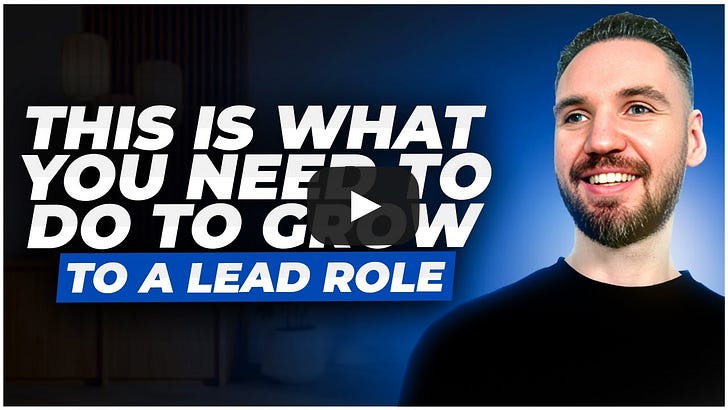 New video every Sunday. Subscribe to not miss it here: DevStatsSpecial thanks to Phil Alves and DevStats for being a long-term sponsor of this newsletter; they’ve sponsored 24 newsletter articles over the course of 2 years! If you haven’t checked them out yet, they have an awesome product, which I have looked at extensively and also used in one of my projects → and it has helped us a lot. Liked this article? Make sure to 💙 click the like button. Feedback or addition? Make sure to 💬 comment. Know someone that would find this helpful? Make sure to 🔁 share this post. Whenever you are ready, here is how I can help you further
Get in touchYou can find me on LinkedIn, X, YouTube, Bluesky, Instagram or Threads. If you wish to make a request on particular topic you would like to read, you can send me an email to info@gregorojstersek.com. This newsletter is funded by paid subscriptions from readers like yourself. If you aren’t already, consider becoming a paid subscriber to receive the full experience! You are more than welcome to find whatever interests you here and try it out in your particular case. Let me know how it went! Topics are normally about all things engineering related, leadership, management, developing scalable products, building teams etc. You're currently a free subscriber to Engineering Leadership. For the full experience, upgrade your subscription. |
Similar newsletters
There are other similar shared emails that you might be interested in:


